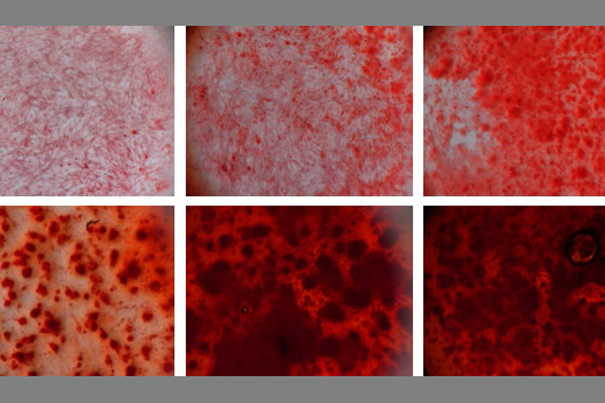
Researchers have found that silicate nanoplatelets can stimulate stem cells to become bone cells, as determined by the formation of bone matrix (in red).
Image courtesy of Khademhosseini Lab
Using clay to grow bone
Synthetic silicate may stimulate stem cells into bone cells
Researchers from Harvard-affiliated Brigham and Women’s Hospital (BWH) are the first to report that synthetic silicate nanoplatelets (also known as layered clay) can induce stem cells to become bone cells without the need of additional bone-inducing factors. Synthetic silicates are made up of simple or complex salts of silicic acids, and have been used extensively for various commercial and industrial applications, such as food additives, glass and ceramic fillers, and anti-caking agents.
The research was published online Monday in Advanced Materials.
“With an aging population in the U.S., injuries and degenerative conditions are subsequently on the rise,” said Harvard Medical School Associate Professor of Medicine Ali Khademhosseini of the BWH Division of Biomedical Engineering, the senior author of the study. “As a result, there is an increased demand for therapies that can repair damaged tissues. In particular, there is a great need for new materials that can direct stem cell differentiation and facilitate functional tissue formation. Silicate nanoplatelets have the potential to address this need in medicine and biotechnology.”
“Based on the strong preliminary studies, we believe that these highly bioactive nanoplatelets may be utilized to develop devices such as injectable tissue repair matrixes, bioactive fillers, or therapeutic agents for stimulating specific cellular responses in bone-related tissue engineering,” said Akhilesh Gaharwar of the BWH Division of Biomedical Engineering, the study’s first author and a visiting fellow at the Wyss Institute for Biologically Inspired Engineering at Harvard University. “Future mechanistic studies will be performed to better understand underlying pathways that govern favorable responses, leading to a better understanding of how materials strategies can be leveraged to further improve construct performance and ultimately shorten patient recovery time.”
This research was supported by the National Institutes of Health, U.S. Army Engineer Research and Development Center, Institute for Soldier Nanotechnologies, and the National Science Foundation.
Click here to view the full manuscript.





